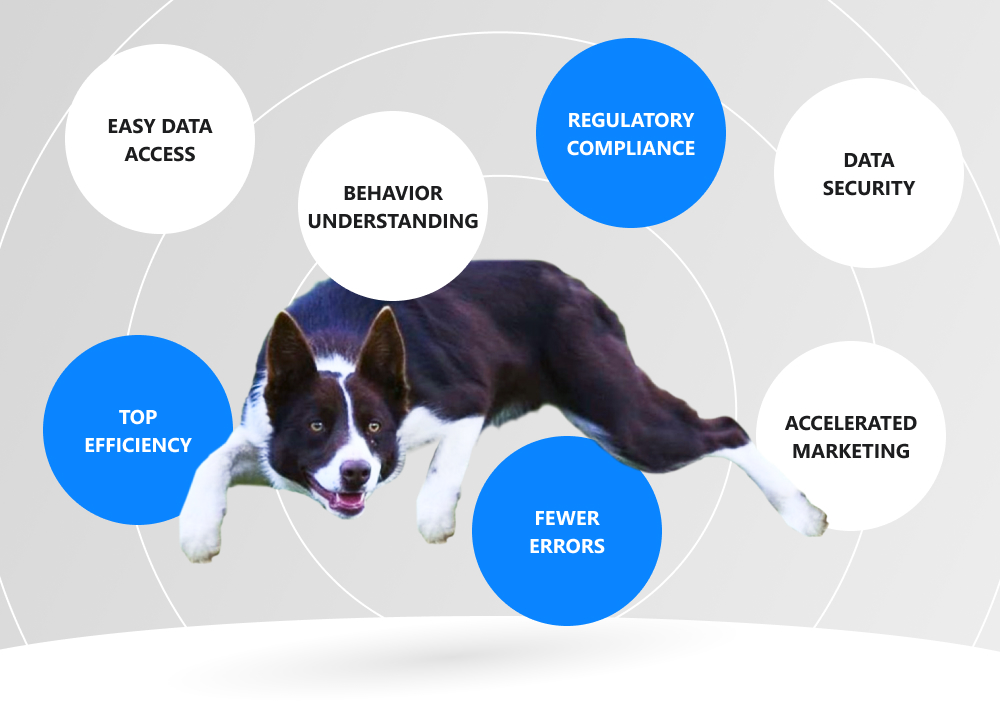Do you know how many people there are online? As things stand now, 6 out of 10 people worldwide have access to the internet. What an impressive audience, huh? It would be insane to miss this advantage to extend your reach for your business. So, the correct answer to the challenge "how to build a customer data platform" to know your clients better is a considerable contribution on your road to triumph.
In our fresh as a daisy article we will provide you with comprehensive directions on building customer data platforms. Hurry to get our experts' insights!
WRITTEN BY:
Alexey Kovsh
Senior Solutions Architect
Contents
Why Do You Need a Customer Data Platform?
It’s a common problem for many companies to have a ton (or two) of customer data scattered all over the place: across different departments, software, and silos. This makes it challenging to get a complete picture of your clients and their needs. Is there any way to organize it properly, so you don’t spend hours searching for the specific customer data you need? Fortunately, yes. The answer: a customer data platform.
The core promise of such a platform is to consolidate all customer data on a unified customer database platform. This powerful solution undertakes various marketing automation tasks, from standard reporting to upgraded user activation strategies, like activating personalized UI tools or showing offers derived from customers' behaviors.
It's not rocket science that thanks to technology, we can capture the entire customer journey. You can extract information about what products your customers searched for, what they clicked or ignored, and their eventual purchases. Moreover, you can enrich this journey by utilizing data from your enterprise customer touchpoints — management systems, customer support, marketing platforms, invoice management products, etc.
No surprise that data integration enables us with even more encouraging use cases beyond traditional reporting. We are witnessing the current development of tools for data structure optimization that enable us to capture, process, analyze, and productize collected data.
According to the latest report by Markets and Markets, the market size of customer data platforms reached $4.8 billion in 2022. It indicates their readiness for the rush for industry leadership. Furthermore, they estimated its significant growth to $19.7 billion by 2027 (while in 2020, it was only $2.4 billion, by the way).
What Does a Customer Data Platform Do?
So, let us see how such platforms work. As we've mentioned above, customer data platforms are database software. They enable your marketing team to learn about your customers and understand them much better.
A customer data platform integrates data from different sources into a complete picture of all the data about your customers and their behaviors. The platform can also segment your customers and their preferences, and you will be able to adjust highly targeted marketing campaigns.
A typical CDP has tools for:
- collecting, normalizing, and integrating data from external and internal sources;
- indefinite data storage (you can use it at any time later);
- data sharing with your systems and channels;
- stable data analysis and reporting schedule of all collected data.
Your Own Customer Data Platform: Valuable Benefits
First, we should note that the 2030 Today Report stated the phenomenal retention rate of customer data platforms among businesses across the world. They found out that 86% of the surveyed decision makers plan to continue introducing customer data platforms into their processes.
Furthermore, for 73% of the respondents, data management platforms are crucial for productive customer engagement strategies.
So, what are the reasons for such broad support? And let us see how you can benefit from them.
What You Get with a CDP
Did you know that for an average business, it is typical to use about 28 data sources for customer insights generation (according to Deloitte)? With a customer data platform you can collect, analyze, and utilize these valuable assets.
We have also handpicked some more essential perks you should mind. Thus, for example, thanks to a customer data platform (CDP) you will get:
- improved efficiency;
- fewer errors and redundancy;
- easier data activation and access;
- validated understanding of your customers' behavioral data;
- regulatory compliance;
- enhanced data security;
- accelerated marketing campaigns.
Impressive, right? You can turn to off-the-shelf CDP vendor solutions like SAP, Oracle, or Salesforce. But when you build your own customer data platform, you will get several additional advantages:
- Leeway — you can build data structure solutions that are tailored to your particular business data: its sources, models, and issues to be addressed;
- Data Privacy Control — you will be able to comply with strict policies about sensitive customer data within your data warehouse and guarantee privacy and data management across different tools;
- Costs — building a customer data platform is much more cost-effective compared to buying and deploying third-party SaaS solutions; it can save you hundreds of thousands of dollars of investments.
Building a Customer Data Platform: Five Stages
So, there is no reason to delay the creation process. Let us focus on the process of implementing your own customer data platform, which requires five essential steps.
#1. Collect and Integrate the Data
The first thing you have to concentrate on is the consolidation of all first-party customer data you get into a centralized data warehouse. This stage can include collecting personal attributes (names, IP addresses, emails, etc.), transactions, behaviors, or customer service interactions.
CDPs collect data and integrate it into data systems and sources from sales, marketing, and support. Here, you can use common linkage variables from personal attributes for comprehensive integration.
#2. Clean and Organize the Data
Then you should check whether the data is accurate and complete, and avoid useless data silos. Thus, you should activate solutions for spotting and fixing incomplete or missing fields, removing possible duplicates, validating data accuracy, and resolving discrepancies.
Next, the clean data can be organized by necessary variables like customer segmentation or their location.
#3. Activate Identity Resolution and Data Unification
During the next stage, your customer data platform enriches customer profiles by integrating data sources from multiple sources and second- or third-party data providers for additional business, demographic, interest, or other necessary online and offline data.
Here you can expand the basic set of data collected and activate data enrichment for more detailed insights. You will be able to build a more accurate set of seed segments and enhance further advertising activities with better matching and market reach rates.
#4. Set Off Customer Segmentation
One of the key benefits of a customer data platform is those tools that help identify customers and segment them according to their attributes and behavioral data. It is extremely productive for targeting and personalization.
Customer segments can be built using AI or machine learning. For example, with predictive scoring, your marketing team will get enriched customer profiles for stronger target audience creation.
Besides, customer segmentation solutions of your customer data platform will provide you with gear for:
- advocates identification;
- customer churn prediction;
- detection of potential cross-sell and upsell opportunities;
- customer journey orchestration;
- delivery of relevant recommendations.
Along with it, we recommend that you put efforts into advanced solutions containing Business Intelligence (BI) and data analytics tools.
#5. Expose Customer Data to Other Systems
It is also important to build a system of customer data integration with external channels, so you can ensure the flexibility of your valuable customer data. That is why a customer data platform should be able to merge with any software system through APIs and connectors safely and effectively. It will allow protected access to your data infrastructure for deeper analytics and boosted customer engagement.
Can You Build Your CDP?
We are sure, the answer to the question is positive. And a perfectly fitted customer data platform, which meets your specific needs, provides outstanding prospects for engaging your current and potential customers.
Moreover, customer data platforms help resolve many pain points in business processes. You will be able to improve data quality, upgrade marketing automation, and strengthen customer lifetime value and customer loyalty.
To meet your goals, you should enable effective first-party data collection, unify customer data and integrate with external sources for expanded data enrichment. After that, segment your existing customers and turn data into sales activities, customer support or marketing campaigns, and more.
And last but not least, prepare to integrate your customer data with external channels and establish a potential for future growth.
Do you want to develop your own customer data platform? At Qulix, we are ready to consult you about our top-notch Adtech software development services and discuss various cooperation options. For more details, please get in touch with our support team.

Contacts
Feel free to get in touch with us! Use this contact form for an ASAP response.
Call us at +44 151 528 8015
E-mail us at request@qulix.com










